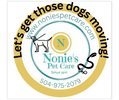|
The winter holidays are a magical time, punctuated with glittering lights, shimmering ornaments, Christmas trees, and brightly colored garlands. Not only are all these things fun for us, but they’re also intriguing to our pets. However, before you set up your tree and start taking out your decorations, take a moment to consider these Christmas tree safety tips to keep your pup happy, safe, and healthy throughout the holidays. Dog Christmas Tree Safety TipsIt can be very difficult to keep a young puppy away from the Christmas tree, particularly if this is their first Christmas. Even an older dog—who may have learned not to jump on the tree—can still be curious. Here are a few pet safety hazards and precautions you should consider. 1. Don’t Let Them Chew on Branches and NeedlesA live tree can be especially dangerous to pets. Dogs like to chew on a tree’s limbs, and the fir tree oils can be irritating to your pup’s mouth tissue, causing symptoms like drooling and vomiting. If your pet is chewing on the branches, there’s a pretty good chance that they are also swallowing the needles. When ingested, pine needles can get caught in a dog’s intestinal tract, puncturing the lining or bunching together and causing an intestinal obstruction. Both can be fatal. Additionally, you should be careful with artificial trees as pets are likely to chew those crunchy needles, too. These trees can cause the same kind of obstruction in a dog. The best way of protecting your pup from these afflictions is limiting their access to the area around your Christmas tree. Consider purchasing a dog-friendly gate or pen to surround the Christmas tree. 2. Don’t Let Them Ingest Fake SnowFake snow—also called flocking—is a popular Christmas tree decoration. However, it can cause serious problems in pups when large amounts of it are swallowed. If you’re going to have a tree in your home, it’s best to get a regular, non-flocked tree. 3. Keep Them Away From Christmas Tree WaterSome trees are treated with chemical preservatives to keep them fresh longer. These chemicals drain into the water in the base of the tree, making the water poisonous to drink. Dogs will drink the water if the base of a tree is left uncovered. You should cover your tree’s water with a tree skirt, towel, plastic wrap, or aluminum foil. However, putting a gate or pen around your tree is the safest and best preventative of toxicity in pups. 4. Maintain a Barrier for Christmas Tree LightsChristmas lights should be positioned away from the bottom of the tree. Electric cord injuries will damage a dog’s mouth tissue and can lead to long-term problems eating, difficulty breathing, and even death. Regularly check the electric light cords frequently for signs of chewing (which is also a fire hazard). To ensure your pup’s safety, put a gate or pen around your tree. You can also buy plastic fish tank tubing, split them, and cover your lights. This makes them much more chew-proof. 5. Keep Ornaments Out of Reach Hang your ornaments on the uppermost branches of your tree and tightly secure them on the branches. It’s better if you select tree ornaments that don’t easily shatter. For delicate glass, treasured, or priceless ornaments, consider creating an area where they can be displayed that is far out of reach of your dog's tail, paws, or mouth. You can hang these from a garland that’s placed across a mantel, over a doorway or window, or you can hang them in shadowboxes on the wall. 6. Remove the Threat of Tinsel, Strings, and Candy CanesTinsel is one of the most dangerous tree decorations you can choose. If your pet ingests even a few strands of tinsel, they are highly likely to develop an intestinal obstruction. This also occurs when edible ornaments—such as popcorn and cranberry strings and candy canes—are ingested by your pup. These strings can tear a dog’s intestines and can be fatal. Leave these decorations off your tree. Other decorations that can be deadly to dogs (and children) include:
By following these tips, you can be confident in creating a happy, healthy holiday season with your furry, four-legged family member. WRITTEN BY Hanie Elfenbein, DVM, Veterinarian Dr. Elfenbein graduated from the University of California, Davis School of Veterinary Medicine in 2016. She currently practices in...
0 Comments
Leave a Reply. |
Archives
July 2024
Categories |

 RSS Feed
RSS Feed